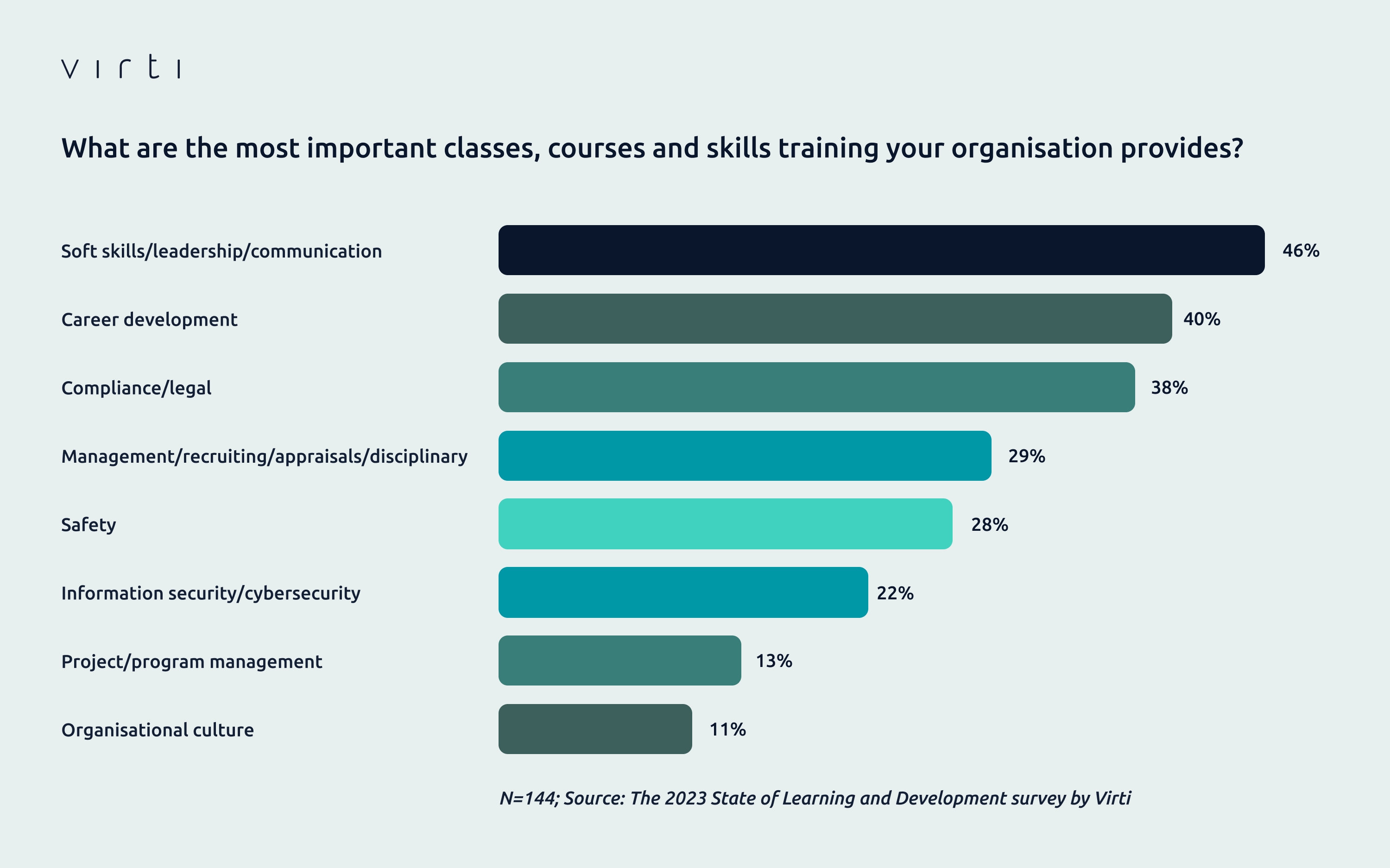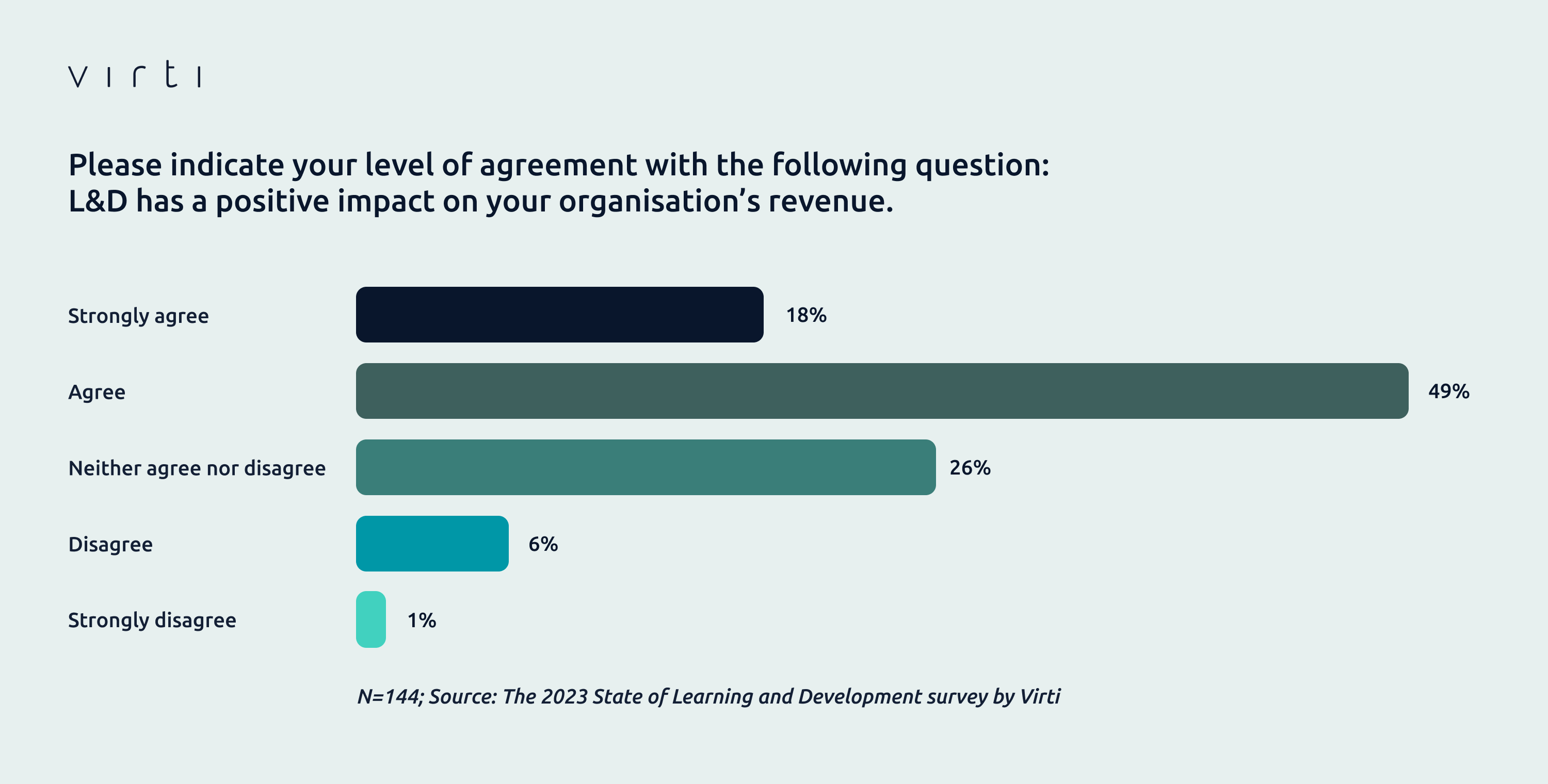Survey Finds Learning & Development Programmes Positively Impact Revenue
London, UK – May 10, 2023: The 2023 State of L&D Report by Virti Shows Whilst Most UK Companies Implement Training for Compliance yet Courses on Softskills are Most Important and Benefits Stretch Beyond

Most UK companies initiate and maintain learning and development (L&D) programmes to meet compliance requirements – many deem soft skills to be the most important training they offer – and overall, L&D has a positive impact on revenue. That’s according to a new report by Virti titled “The 2023 State of Learning and Development.” The findings are based on a recent survey of 144 UK-based L&D professionals.
Among the top reasons respondents said their organisations conduct training are to ensure compliance (50%), improve employee technical skills (49%); and support their career development (39%). However, respondents also believed courses such as leadership and communication (50%), are the most important offered. Importantly, about two-thirds (67%) said L&D has a positive impact on revenue.
“While the cause and effect aren’t always linear, leaders should be careful to not overlook such significant business outcomes,” said Virti CEO Kurt Kratchman. “Some survey-takers aptly noted in open ended comments ‘L&D attracts energized talent’ and fosters ‘a culture of innovative curious thinking,’ which are productivity factors that are inherently difficult to assess in a spreadsheet.”
Top challenges facing L&D
Most L&D professionals answering the survey said “budget” (57%) was their top challenge. This was followed by “driving employee engagement” (37%) and “measuring results” (29%). Interestingly, obtaining executive support ranked near the bottom of the list of challenges, suggesting L&D professionals enjoy the broad support of their leadership.
“There is plenty of evidence in this survey indicating most companies see L&D as a compliance function – which by definition is a necessity,” added Kratchman. “So, it stands to reason that executives support the function for compliance purposes, but they are less inclined to spend more than they have to on training.”
He continued, “What respondents in this survey are collectively saying is that key leaders should flip that view on its head. L&D isn’t a cost center – it’s a revenue driver. Training is an investment in your team.”

Additional findings from the survey
Other high-level findings from the survey include the following:
- Training materials are largely produced in-house. 53% of respondents said most of the training content they produce is created in-house; 31% use a mix of in-house and outside resources to create classes and courses; just 17% rely mostly on external content providers.
- The shelf life of a training course is short. While much depends on the subject matter, 50% of respondents said training courses typically last a year or less; 40% said courses last two or three years.
- Flexible learning options. Most L&D organisations are providing learners with flexible options for learning: 60% said they offer courses remotely, live and in-person; 56% said training can be completed anywhere and anytime from a computer or laptop.
- Modest adoption of digital immersive training; noteworthy benefits. 39% of L&D departments train their teams in digitally immersive environments, such as virtual reality (VR) or augmented reality (AR) at least some of the time. These respondents said VR/AR provides better quality training and is more cost-effective in the long run.
- Most L&D professionals report to HR. 62% of respondents said L&D reports to human resources (HR). Another 10%, the second most, report to the CEO. Half (50%) said the L&D function has both centralised and decentralised teams. About one-third (33%) of respondents said L&D leaders have titles commonly considered executive-level including Chief Learning Officer (CLO).
“The takeaway for business and organisational leaders is that L&D isn’t about checking a box,” Kratchman said summing up the survey results. “L&D has a direct influence on organizational development goals and corporate culture – and by extension an indirect influence on growth and revenue.” A complimentary copy of the report is available for download here: “The 2023 State of Learning and Development.”
About Virti
Virti’s cutting-edge platform provides virtual reality and augmented reality (VR/AR) to give your team the power to create immersive learning experiences inspired by your real world. Whether it’s managerial skills or warehouse safety, traditional training can be difficult to scale, expensive, and unable to recreate real-life scenarios. This includes, recreating hard-to-replicate real-life scenarios with 360 immersive interactive videos, helping learners practise their soft skills with AI-assisted avatar roleplay and using AI give your learners real-time feedback and keep tabs on important metrics. L&D teams using VR/AR tools for training typically see a 230% increase in knowledge gain; 60% reduction in onboarding time and 97% feel better prepared when put in difficult situations. Ready to start creating environments where your teams love learning? Visit www.virti.com to learn more.
Media Contact:
Frank Strong, for Virti
+1 202-352-5920 (also on WhatsApp)
frank@swordandthescript.com
